#museo chiaramonti
Photo
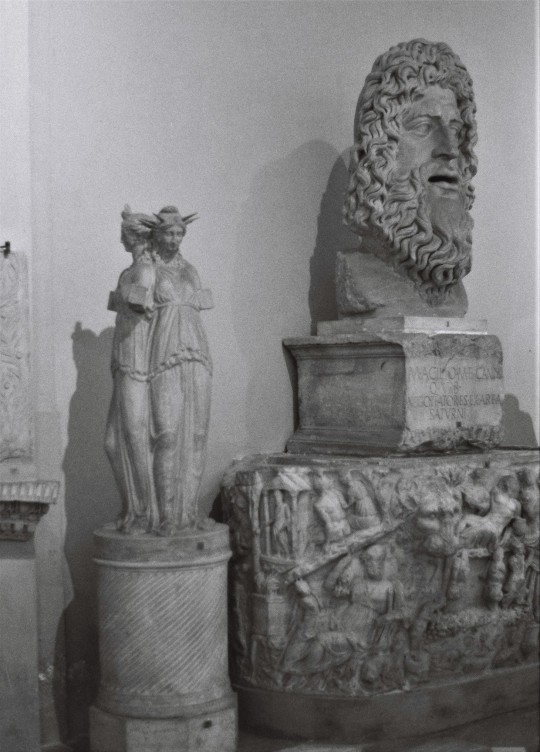

Inv.-Nr. 1922, Museo Chiaramonti, Rome
triple-bodied Hecate
Roman copy (early third century) after an original of the Hellenistic period
Ancient chthonic goddess, daughter of the Titan Perses and Asteria, originating from Caria; very diverse in her functions. She helps kings in the administration of justice, people in counselling and war, protects hunting and fishing, helps women in childbirth and raising children, protects gates and paths (often with haunting), therefore with a ghostly character and goddess of folk superstition, accompanied by the souls of the violently dead; according to Hesiod, she is directly descended from the Titans; she is related to the underworld and to magic; she is often depicted as a circular group of three female figures with their backs turned to the centre, each carrying a torch and accompanied by a dog; howling dogs announced her nocturnal approach; patroness of magic and superstition until the Middle Ages; also represented in the great frieze of Pergamon
#ancient rome#museo chiaramonti#hecate#hellenistic#goddess#titans#underworld#magic#greek mythology#hekate#witch#roman sculpture#ancient greece
84 notes
·
View notes
Text

Marble bust of the great Athenian general, orator, and statesman Pericles (ca. 495-429 BCE), shown here wearing a Corinthian helmet. Pericles is credited by many historians, notably Thucydides, with guiding 5th century BCE Athens to its peak of greatness; among his achievements were the ambitious building program on the Parthenon and the conversion of the Delian League, originally formed to combat the Persians, into a tribute-paying Athenian empire. His reputation was not, however, unblemished. His political opponents accused him of aiming at tyranny, while his enforcement of the Megarian Decree--which barred Sparta's ally Megara from all Athenian harbors and was effectively an act of economic warfare--may have been the proximate cause of the Peloponnesian War. His death from plague plunged Athens into crisis and led to a succession of populist leaders such as Cleon and Hyperbolus, whose far more aggressive foreign policy ultimately proved disastrous for Athens. Though the city would survive and even make a second attempt at empire-building, it never regained the unchallenged supremacy it had enjoyed in the Periclean period.
Roman copy of uncertain date after a lost Greek original. Now in the Museo Chiaramonti, Vatican City.
#classics#tagamemnon#Ancient Greece#Classical Greece#ancient history#Greek history#Ancient Greek history#Pericles#Perikles#art#art history#ancient art#Greek art#Ancient Greek art#Classical Greek art#sculpture#portrait sculpture#portrait bust#marble#stonework#carving#Museo Chiaramonti#Vatican Museums
191 notes
·
View notes
Text
Fate Grand Order Servant Comparisons
Asclepius
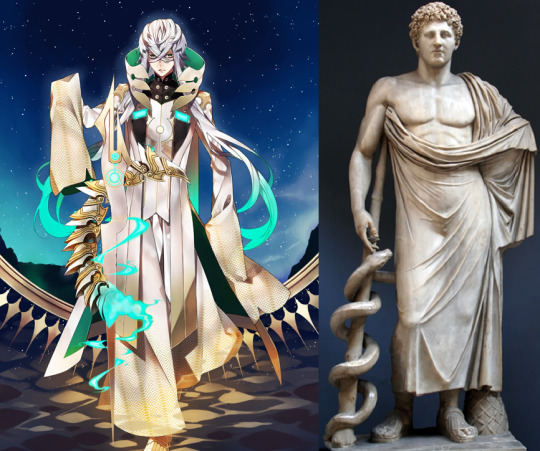
Left - FGO
Right - Roman copy after a Greek original sculpture dating from the 4th century BC. Rome, New Wing ("Braccio Nuovo" hallway), Museo Chiaramonti, Vatican Museums
8 notes
·
View notes
Photo

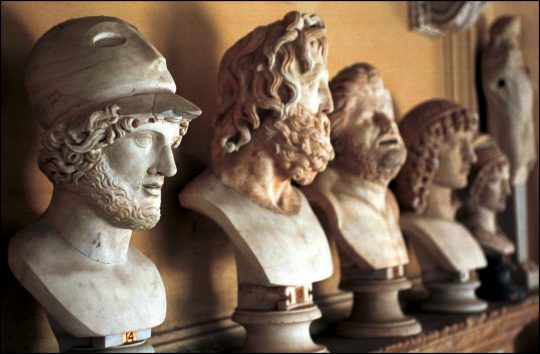
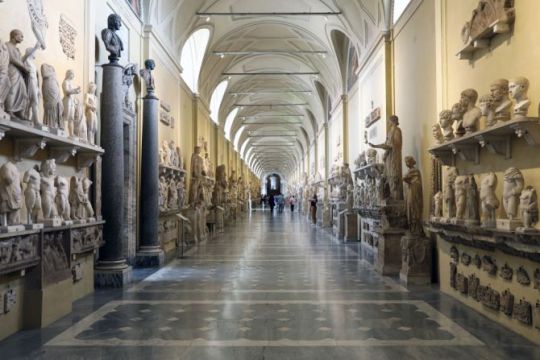
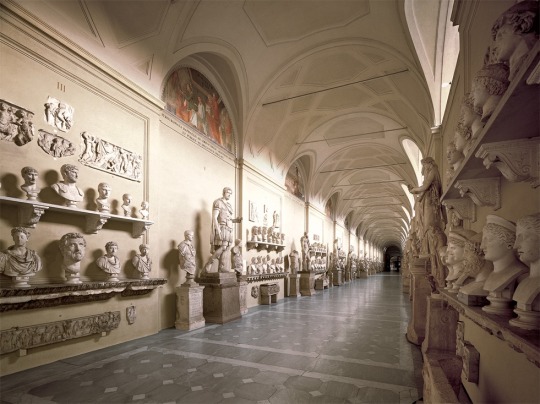
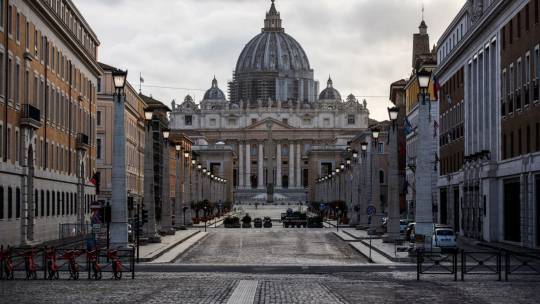
American Tourist Smashes Two Roman-Era Sculptures in the Vatican
Just when you thought the summer of tourists behaving badly was over, another person on vacation wrecks another priceless artifact.
This time it's the turn of an American tourist who smashed no fewer than two ancient Roman sculptures into pieces at the Vatican on Wednesday.
The episode took place in the Museo Chiaramonti, part of the Vatican Museums, around lunchtime. The space holds around 1,000 works of ancient statuary, and describes itself as "one of the finest collections of Roman portraits" in the world.
Two of those portraits are now facing an uncertain future after the tourist knocked over one in anger, then toppled another as he fled the scene.
The man had demanded to see the pope, according to newspaper Il Messaggero. When he was told he couldn't, he allegedly hurled one Roman bust to the floor.
As he ran off, with staff in pursuit, he knocked down another.
The two works of art have been taken to the inhouse workshop to be assessed. While around 2,000 years old, they are thought to be secondary works of art, rather than famous works, a source told Il Messaggero.
Director of the Press Office for Vatican Museums Matteo Alessandrini said that the American man, around 50 years old, was in the "Galleria Chiaramonte" corridor, which houses around 100 busts and statues.
"The busts were affixed to shelves with a nail but if you pull them down with force they will come off," he said. "He pulled down one and then the other and the guards came immediately and stopped him and consigned him to the Vatican police who brought him in for questioning. Around 5:30 p.m. he was handed over to the Italian authorities.
"The 2 busts have been damaged but not particularly badly. One lost part of a nose and an ear, the head of the other came off the pedestal."
He said that restoration work had already begun, and that "they will soon be restored and back at the Museum."
Mountain Butorac, who leads pilgrimages to the Vatican and who often visits the Museo Chiaramonti, said: "One of the beautiful things is that it allows the visitors to get literally face to face with these ancient sculptures. My fear is that with behavior like this, barriers could be put in place."
Tourists damaging monuments has been a theme of this summer in Rome. In July, a Canadian tourist was caught carving her name into the Colosseum, while American tourists were caught hurling scooters down the Spanish Steps, breaking off pieces in the process, and a Saudi visitor drove his Maserati down the same architectural icon.
By Julia Buckley.
#American Tourist Smashes Two Roman-Era Sculptures in the Vatican#Museo Chiaramont#Vatican Museums#sculptures#roman sculptures#roman busts#ancient artifacts#history#history news#art#artist#art work#art world#art news#ancient rome#roman history#roman empire
22 notes
·
View notes
Text
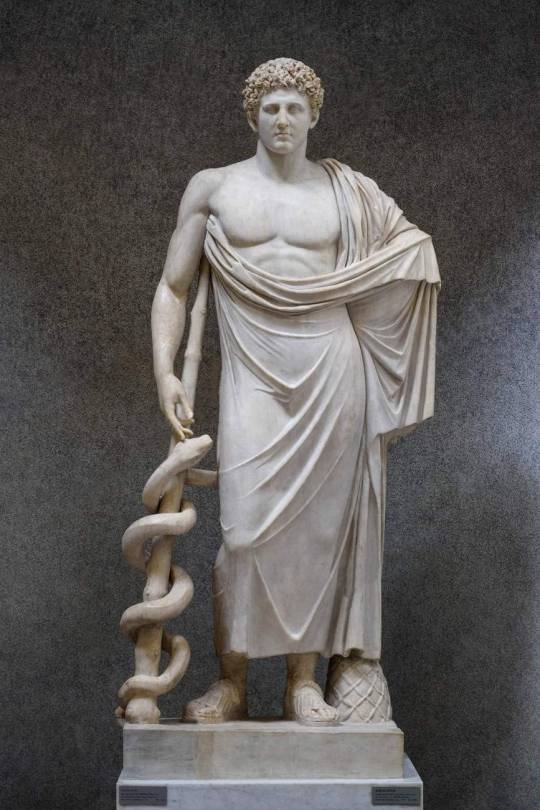
Asclepio, figlio di Apollo e della ninfa Coronide era il dio della medicina. Sacrificò la sua vita per salvare le persone fino a quando non venne colpito dal fulmine di Zeus per aver iniziato a resuscitare i morti. Era molto venerato in Grecia. Il centro del suo culto era la città di Epidauro con il suo famoso santuario. Una statua cultuale in bronzo di Asclepio, realizzata ad Atene nel terzo quarto del V secolo a.C., fu probabilmente opera degli allievi dello scultore Mirone. La scultura nell’immagine, copia romana del II secolo d.C. da originale greco del IV secolo a.C., proveniente dal Quirinale, è conservata a Roma nel Museo Chiaramonti.
8 notes
·
View notes
Text
If you are thinking of traveling to Vatican City, Vatican, you are in the right place. The Vatican is the center of the Roman Catholic Church. In 1929, it declared its independence with the approval of Mussolini, as a continuation of the Papal State, which had existed for hundreds of years.
[embed]https://www.youtube.com/watch?v=nmzbYsXRQ-M[/embed]
Where Is Vatican City?
Let us share with you some of the things you need to know when traveling to Vatican City. Vatican City is a state within a state, spread over an area of approximately 44,000 square meters in Rome, Italy. In this respect, it has the distinction of being the smallest country in the world. The city, built on the Vatican Hill, is surrounded by walls.
When To Go To Vatican City?
You can visit the Vatican during your visit to Rome. Italy has a milder climate than Europe. Therefore, visiting the city will be enjoyable in any season.
Trip To Vatican City
The Sistine Chapel is one of the most famous buildings in the Vatican. Made by Pope IV. It was completed in 1477 during the reign of Sixtus. The Sistine Chapel was named after Pope IV. From Sixtus. Papal elections have been held here since its inception. The Sistine Chapel, designed by Baccio Pontelli and Giovanni de Dolci, is one of the best examples of the Renaissance.
The most important feature of the building is the ceiling decorations that Michelangelo completed in four years. Many stories are depicted in these frescoes. The most famous of these are "The Creation of Adam" and "Judgment Day".
These frescoes made by Michelangelo were restored between 1984-94. These works, which were known to be quite dark before, were revealed to be the result of layers of dirt for many years, and at the end of the restoration, the frescoes became brand new with their brightness.
The architectural features of the Sistine Chapel were shaped according to the Temple of Solomon described in the Bible. The structure covered with a barrel vault is 40.93 meters long, 13.41 meters wide and 20.70 meters high.
Vatican City Museums
Pope II. It was founded by Julius in the early 16th century. The Vatican Museums house one of the largest art collections in the world. In the exhibition area consisting of 7 kilometers of halls and corridors; There are Egyptian mummies, Etruria bronze ancient busts, works from old masters and modern art. Vatican Museums consist of many sections;
Pio-Clementine Museum (Museo Pio-Clementino)
Pope XIV. It was founded by Clement in 1771. This museum, where Renaissance and ancient artifacts were exhibited, was built by Pope VI. It was enlarged by Pius. There are 54 galleries in total here, including the Sistine Chapel. The Sistine Chapel can be entered with an award after visiting 53 other galleries.
Chiaramonti Museum
Pope VII. It was founded in the early 19th century by Pius Chiaramonti. The museum consists of large arched galleries displaying statues, sarcophagi and friezes. The New Wing and Braccio Nuovo, built by Raphael Stern, display important sculptures such as the Prima Portal Augustus, Doryphorus and The River Nile. There are more than 3,000 tablets and inscriptions in the Lapidaria Gallery, another part of the Chiaramonti Museum.
This gallery is the largest of its kind. However, this section can only be entered with special permission for academics.
Gregorian Etruscan Museum
Pope XVI. It was founded by Gregory in 1836. The museum, which consists of eight galleries, is home to artifacts found in Etruria archaeological excavations. It contains; vases, sarcophagi, bronze artifacts and the Guglielmi Collection.
Gregorian Egyptian Museum
Pope XVI. It was founded by Gregory in 1839. The museum houses a large collection of Ancient Egypt. The Grassi Collection, animal mummies and a reproduction of the famous Book of the Dead are housed here.
Vatican History Museum
Vatican History Museum Pope VI. It was founded by Paul in 1973. The museum, which was first built
under the Square Garden, was later moved to the main floor of the Lateran and reopened in March 1991. The Vatican History Museum has portraits of all popes since the 16th century. The costumes worn by the army and the clergy are also exhibited here. Downstairs is the collection of cars used by the popes to this day.
St. Peter's Square
St. Peter's Square is one of the biggest symbols of the Vatican. Pope VII between 1656-67. It was made by Gian Lorenzo Bernini under the leadership of Alexander. The entrance gates of the Vatican open to this square. An Egyptian obelisk rises in the middle of the square. This obelisk was erected some 100 years before Bernini designed the square. The square was built to enable the pope to address a large audience from a single point.
St. Peter's Basilica
St. Peter's Basilica is one of the largest structures forming the silhouette of Rome with its dome. Architecturally it is a late Renaissance church. Many masters such as Donato Bramenta, Michelangelo, Carlo Maderno and Gian Lorenze Bernini contributed to the design. Art, as it is known in the Renaissance period, was in the hands of the church. The more the artists liked the church, the more fame and money they could have.
(adsbygoogle = window.adsbygoogle || []).push();
Therefore, the Papal history is very rich in artistic terms. The building is one of the two largest churches in the world in Renaissance architecture.
St. Peter's Basilica was consecrated and opened for worship on November 18, 1626, and is rumored to be located on the spot where St. Peter was crucified in 67 AD. That's why this place is one of the pilgrimage points of Christians.
Another important part of the building is the Pietà sculpture made by Michelangelo at the age of 25. Michelanelo has officially given life to marble here. Thin and curved textures create a perfect harmony. Everything from the realistic creases of the clothes demonstrates an incredible ability to observe and the human anatomy in its truest form.
Another feature of this statue is that the Virgin Mary is depicted as a young person for the first time. Michelangelo expressed this as an indication of the virginity and purity of Mary.
(adsbygoogle = window.adsbygoogle || []).push();
In the statue, Jesus was lowered from the cross and his dead body was spread on Mary's lap. The sculpture is also the only work Michelangelo signed. Actually, it has an interesting story. When Michelangelo completed this sculpture to be exhibited in the church, no one knew him yet. When he went to the place where the statue was, it gave him great happiness that everyone praised the statue.
However, there were various rumors about who did it, and in those years when the intercity competition was at a high level, one group claimed that it was done by a Milanese person, while another group claimed that it was done by a Neapolitan sculptor.
Saddened by this, Michelangelo stated to the church that the statue was not yet completed and asked permission to work, and had the church closed. When he completed his work, he signed the Latin "Michelangelo from Florence Made" on the belt that held Mary's dress together.
Transportation-In-Vatican-City
When you travel to Vatican City, you should also know how to get there. There are no means of transportation in the Vatican. At the same time, the Vatican is a very small city and you can explore the city on foot.
Vatican City Cuisine
Your trip to Vatican City continues, if you can't decide what to eat, then it's time to talk about what to eat in Vatican City. Vatican's cuisine originally consists of Italian cuisine. There are several restaurants in the city serving delicious Italian cuisine. The most popular restaurants are Old Bridge, Siciliainbocca and Insalata Ricca. If you wish, you can also choose the restaurant inside the Vatican Museum. However, it would be a more appropriate choice to dine at the restaurants in Rome instead of the ones in the Vatican.
(adsbygoogle = window.adsbygoogle || []).push();
There are countless restaurants in Rome that serve the best flavors of the world-famous Italian cuisine. In the city; There are many options from seafood to risotta, from delicious Italian pizzas to vegans and vegetarians.
Shopping In Vatican City
Wouldn't you like to beautify your Vatican City trip with shopping? Shopping opportunities in the Vatican consist of postage stamps and souvenirs.
Vatican City Nightlife
Since the Vatican is a religious center, it is not possible to talk about nightlife. In the evening, you can take photos of the structures and places that should be seen in the city. To have fun at night, you should decide the places in Rome. When you travel to Vatican City, do not leave without tasting the nightlife!
Vatican City Public Holidays
New Year (1 January),
Epiphany (January 6),
Easter (March/April),
Independence Day (25 April),
Labor Day (May 1),
Republic Day (2 June),
S. Pietro E Paolo (29 June, Rome only),
Assumption (August 15),
Christian Festival (November 1),
Immacolata Concezione (8 December),
Christmas (25 December)
Vatican City Practical Information
Emergency Assistance: 112 / 118
Police: 112 / 113
Fire: 112 / 115
Phone Code: +379
0 notes
Text
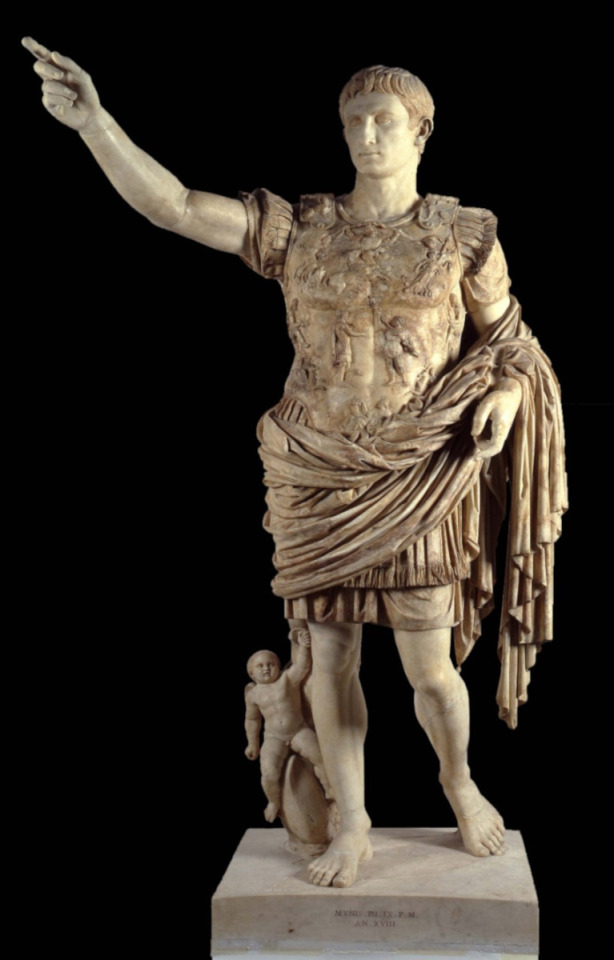
TITOLO: Augusto di prima Porta
DATAZIONE: 27 a.C.
LUOGO DI CONSERVAZIONE: Città del Vaticano museo Chiaramonti
TECNICA: scultura in marmo da originale bronzeo
DETTAGLI: questa è un’altra raffigurazione di Augusto diversa dalla precedente, difatti Augusto indossa il paludamentum ovvero un lungo mantello che sorregge sul braccio e la lorica sul torace, ovvero una corazza in cuoio, che era indossata dai legionari. Quest’ultima ha una funzione allegorica di farti presenta la raffigurazione del re dei parti sconfitto che riconsegna le insegne romane come atto di totale sottomissione. Questo è un altro esempio di strumentalizzazione politica e propagandistica dell’arte per Augusto. Qui Augusto è raffigurato in un momento particolare ovvero nella cosiddetta adlocutio, ovvero il discorso di incitamento alle truppe del comandante dell’esercito, che Augusto tiene con il braccio sollevato proprio per enfatizzarne la solennità.
0 notes
Text
#Hecate#roma#art#arte#culture#museums#travel#musei vaticani#Museos Vaticanos#mitología#Mythology#mitología griega#classical mythology#greek gods#greek mythos#greek myth
0 notes
Text
American tourist smashes two sculptures in the Vatican : Inside US
American tourist smashes two sculptures in the Vatican : Inside US
(CNN) — Just when you thought the summer of tourists behaving badly was over, another person on vacation wrecks another priceless artifact.
This time it’s the turn of an American tourist who smashed no fewer than two ancient Roman sculptures into pieces at the Vatican on Wednesday.
The episode took place in the Museo Chiaramonti, part of the Vatican Museums, around lunchtime. The space holds…
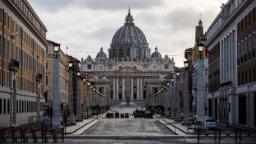
View On WordPress
0 notes
Text
American vacationer accused of damaging Vatican busts after being denied assembly with pope
An American vacationer in Vatican Metropolis was arrested Wednesday, accused of damaging two Roman busts after he was informed he couldn’t meet Pope Francis, in keeping with Italian media.
The unidentified man in his 50s was visiting the Museo Chiaramonti when he demanded to see the pope, in keeping with Italian newspaper Il Messaggero.
Museum employees informed him that wasn’t doable, so the person, native authorities say, proceeded to throw one bust on the bottom after which threw one other one down as he ran away from safety.
The person was ultimately apprehended by safety. He was first handed over to Vatican police after which to Italian authorities.
Matteo Alessandrini, a spokesman for the Vatican Museums, informed CNN that the busts solely suffered minor harm.
“One misplaced a part of a nostril and an ear, the pinnacle of the opposite got here off the pedestal,” Mr. Alessandrini informed the community. He added that restoration work had already begun and the busts will quickly be again of their correct place.
Crimes dedicated in Vatican Metropolis are normally prosecuted and punished by Italy’s secular authorities at Vatican expense.
Vacationers have been notably unruly in Rome over this summer time.
A pair of American vacationers brought on greater than $26,000 of injury to the Spanish Steps in June once they threw an electrical scooter down the landmark, in keeping with the New York Put up.
CNN reported {that a} Saudi man drove his Maserati down the Spanish Steps as effectively, and {that a} Canadian vacationer was additionally caught carving her identify into the Colosseum in July.
Originally published at Irvine News HQ
0 notes
Text

Marble portrait bust of Marcus Antonius (Mark Antony). Artist unknown; 69-96 CE (Flavian period). Found near the Porta Maggiore, Rome; now in the Museo Chiaramonti, Vatican City. Photo credit: Sergey Sosnovskiy.
#classics#tagamemnon#Ancient Rome#Roman Republic#Roman Empire#ancient history#Roman history#Marcus Antonius#Mark Antony#art#art history#ancient art#Roman art#Ancient Roman art#Roman Imperial art#sculpture#portrait sculpture#portrait bust#marble#stonework#carving#Vatican Museums#Museo Chiaramonti
281 notes
·
View notes
Photo
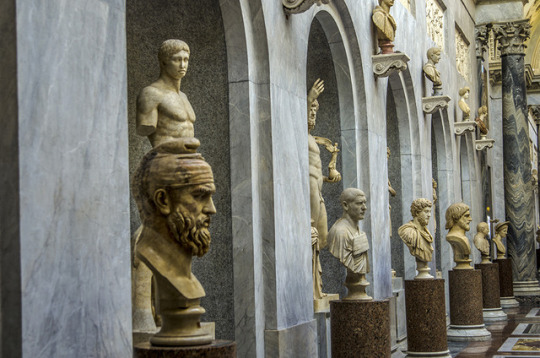
Museo Chiaramonti
Literally hundreds of 2 thousand year old marble scuptures
in the Vatican Museum, Vatican City
15 notes
·
View notes
Video
MUSEO PÍO CLEMENTINO por Carlos Octavio Uranga
#MUSEOS VATICANOS#MUSEI VATICANI#MUSEUMS BRACIO#NUOVO#CHIARAMONTI#ESCULTURA#SCULPTURE#CLASICA#CLASSICAL#GRIEGO#ROMA#ROME#VATICAN#VATICAN MUSEUMS
2 notes
·
View notes
Photo

Portrait of Antinoos-Ganymede
Galleria delle Statue e Sala dei Busti, The Chiaramonti Museum, Vatican
The typical pointed oriental beret suggests an association with the Trojan shepherd, Ganymede, kidnapped by Zeus to become the cup-bearer of the gods.
#art#sculpture#bust#antinous#antinoos#antinoo#αντίνοος#roman sculpture#ancient art#museum#museo pio clementino#pio clementino museum#roman art#ganymede#vatican#the chiaramonti museum#classics#aethstetic#classical art#classical sculpture#classical aesthetic
49 notes
·
View notes
Photo
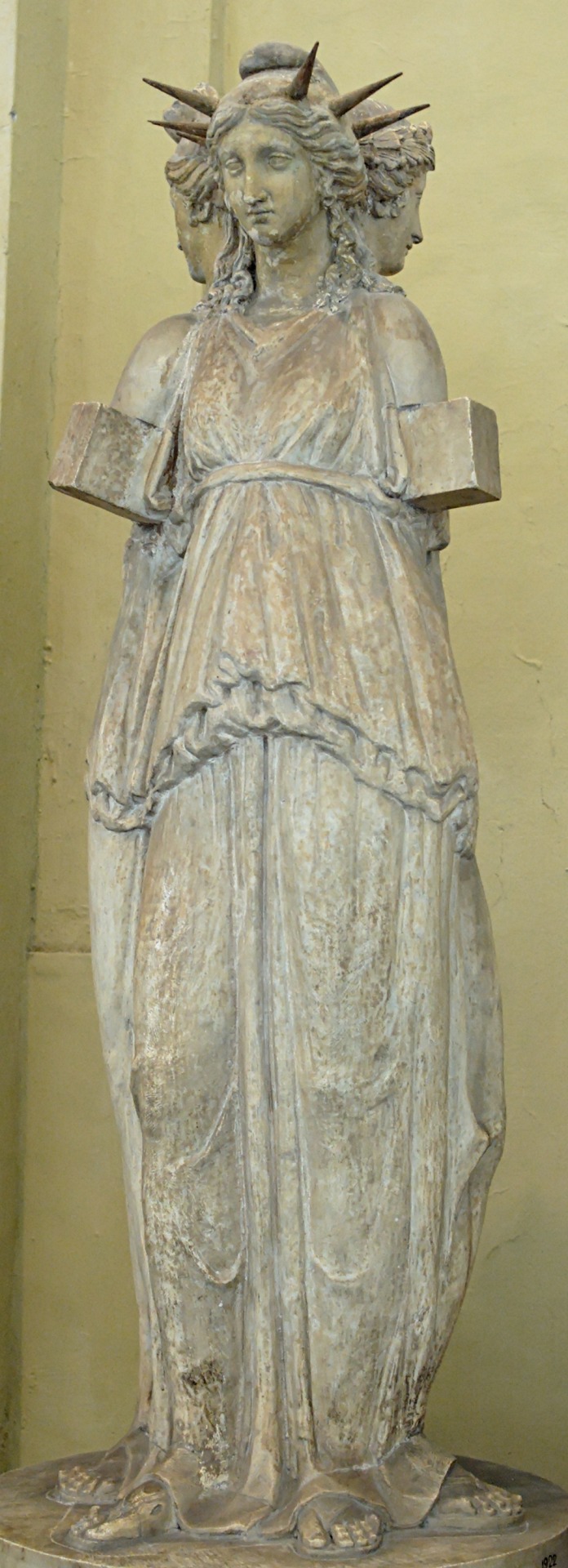
The Hecate Chiaramonti
at the Museo Chiaraminti, Vatican Museums
28 notes
·
View notes
